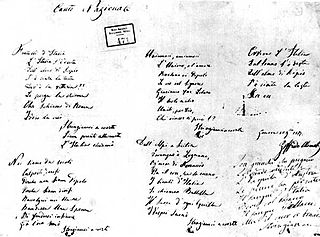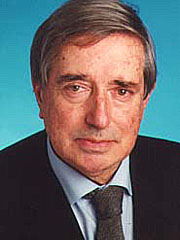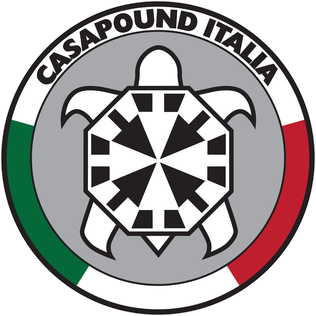Neo-fascism is a post–World War II far-right ideology that includes significant elements of fascism. Neo-fascism usually includes ultranationalism, racial supremacy, populism, authoritarianism, nativism, xenophobia, and anti-immigration sentiment, as well as opposition to liberal democracy, social democracy, parliamentarianism, liberalism, Marxism, capitalism, communism, and socialism. As with classical fascism, it proposes a Third Position as an alternative to market capitalism.

"Il Canto degli Italiani" is a patriotic song written by Goffredo Mameli and set to music by Michele Novaro in 1847, and is the current national anthem of Italy. It is best known among Italians as the "Inno di Mameli", after the author of the lyrics, or "Fratelli d'Italia", from its opening line. The piece, in 4/4 time signature and B-flat major key, has six strophes, and a refrain sung after each. The sixth group of verses, almost never performed, recalls the first strophe's text.

Benedetto Croce, KOCI, COSML was an Italian idealist philosopher, historian, and politician who wrote on numerous topics, including philosophy, history, historiography, and aesthetics. A political liberal in most regards, he formulated a distinction between liberalism and "liberism". Croce had considerable influence on other Italian intellectuals, from Marxists to Italian fascists, such as Antonio Gramsci and Giovanni Gentile, respectively.
Fascio is an Italian word literally meaning "a bundle" or "a sheaf", and figuratively "league", and which was used in the late 19th century to refer to political groups of many different orientations. A number of nationalist fasci later evolved into the 20th century Fasci movement, which became known as fascism.
Fascist symbolism is the use of certain images and symbols which are designed to represent aspects of fascism. These include national symbols of historical importance, goals, and political policies. The best-known are the fasces, which was the original symbol of fascism, and the swastika of Nazism.

Roberto Fiore is an Italian politician and the leader of the party Forza Nuova, convicted in Italy for subversion and armed gang activity and for his links to the right wing terrorist organization "Terza posizione". He self-identifies as a neo-fascist.

Giuseppe Saragat was an Italian politician who served as the president of Italy from 1964 to 1971.
Gioventù Fascista was a magazine designed for youth in Italy under Benito Mussolini's Fascist state. Its features included stories and cartoons praising the regime and inculcating the tenets of Fascism.

The Fasci Italiani di Combattimento was an Italian fascist organisation created by Benito Mussolini in 1919. It was the successor of the Fasci d'Azione Rivoluzionaria, being notably further right than its predecessor. The Fasci Italiani di Combattimento was reorganised into the National Fascist Party in 1921.

The Arditi del Popolo was an Italian militant anti-fascist group founded at the end of June 1921 to resist the rise of Benito Mussolini's National Fascist Party and the violence of the Blackshirts (squadristi) paramilitaries. It grouped revolutionary trade-unionists, socialists, communists, anarchists, republicans, anti-capitalists, as well as some former military officers, and was co-founded by Giuseppe Mingrino, Argo Secondari and Gino Lucetti – who tried to assassinate Mussolini on 11 September 1926 – the deputy Guido Picelli and others. The Arditi del Popolo were an offshoot of the Arditi elite troops, who had previously occupied Fiume in 1919 behind the poet Gabriele d'Annunzio, who proclaimed the Italian Regency of Carnaro. Those who split to form the Arditi del Popolo were close to the anarchist Argo Secondari and were supported by Mario Carli. The formazioni di difesa proletaria later merged with them. The Arditi del Popolo gathered approximately 20,000 members in summer 1921.

Demetrio Volcic, also known in Slovene as Dimitrij Volčič, was an Italian journalist, author, and politician of Slovenian descent. He rose to prominence in the late 1960s and early 1970s as foreign correspondent for the Italian television RAI. In the late 1990s, he served as member of the Italian Senate, and later as Member of European Parliament for the European Socialist Party.

Randolfo Pacciardi was an Italian politician.

The Italian Social Movement was a neo-fascist political party in Italy. A far-right party, it presented itself until the 1990s as the defender of Italian fascism's legacy, and later moved towards national conservatism. In 1972, the Italian Democratic Party of Monarchist Unity was merged into the MSI and the party's official name was changed to Italian Social Movement – National Right.

CasaPound Italia is an Italian neo-fascist movement. It was formerly a political party, born as a network of far-right social centres arising from the occupation of a state-owned building by squatters in the neighborhood of Esquilino in Rome on 26 December 2003. Subsequently, CasaPound spread with other instances of squatting, demonstrations and various initiatives, becoming a political movement.
The Democratic Fascist Party was a clandestine Italian fascist political party. The party is known mainly because its founder and some other members stole the dead body of Benito Mussolini from the Cimitero Maggiore in Milan.

Ivan Matteo Lombardo was an Italian politician.
The Action Party was an Italian pre-unitary political party active during the Risorgimento. It was the first organized party in the history of Italy.

Umberto Bossi is an Italian politician and former leader of Lega Nord, a party seeking autonomy or independence for Northern Italy or Padania. He is married to the Sicilian Manuela Marrone, and has four sons, of whom one was from his first wife.

Alfredo De Marsico was an Italian Fascist politician who served as the last Minister of Justice of the Mussolini Cabinet from February to July 1943. After the war he continued his political career in the National Monarchist Party and later in the People's Monarchist Party.













